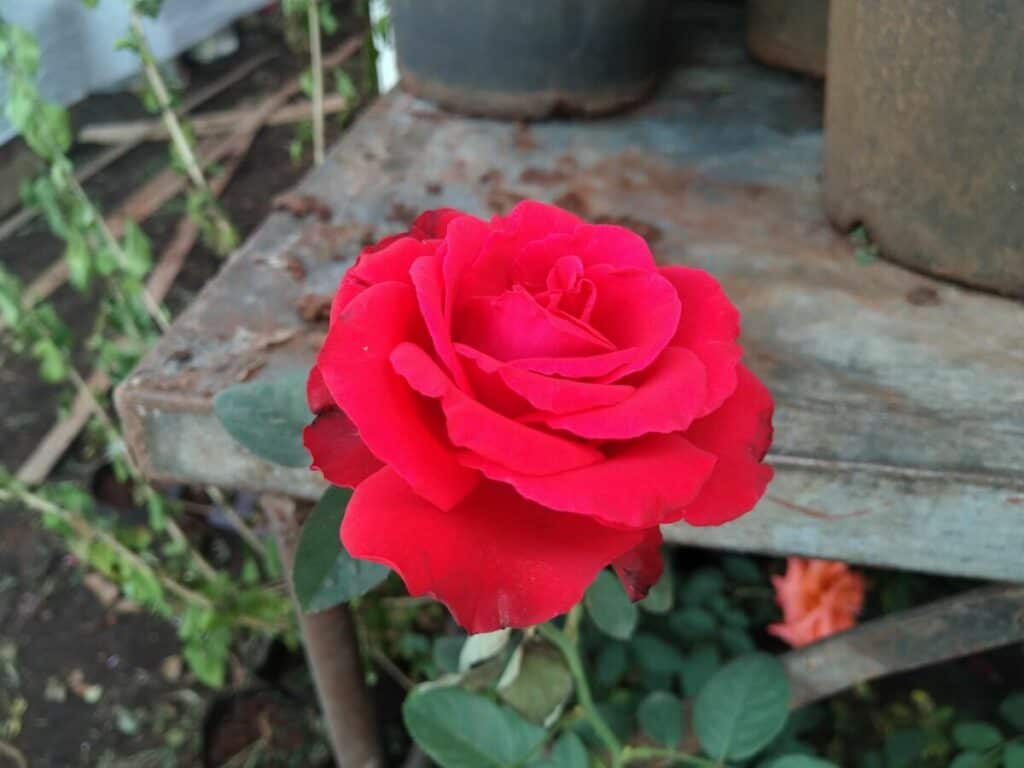Keeping outdoor potted plants healthy doesn’t have to be difficult. While there are plenty of finicky plants out there, low-maintenance species are far more forgiving. Best for busy gardeners with little time on their hands, these plants can stay healthy with minimal care.
I sought out to find the best low-maintenance outdoor potted plants for beginners and seasoned gardeners alike. Here’s what my research uncovered.
1. Knock-out Roses
Believe it or not, you can have your own rose garden even if you don’t have the greenest thumb. Developed in the 1970s, Knock-out roses are a product of careful selective breeding.
These plants are very low-maintenance compared to traditional roses. Not only that, but they’re more resistant to pests and diseases that could harm your precious blooms.
Knock-Outs grow in shrub and tree form. In containers, they stay small, reaching heights of about three or four feet. Light pruning and deadheading are always recommended. But, these rose plants can continue to flourish year after year even if you forget. The same goes for watering. This plant is drought-tolerant, giving you some wiggle room.
2. Butterfly Bush
If you want a plant that attracts winged fertilizers, the Butterfly Bush is a good choice. These shrubs produce fragrant flowers that attract bees, butterflies, and more. They aren’t like your average blossoming flower. Tiny bloom clusters burst from the tip of the branches, creating a unique look.
These plants are hardy up to zone 5. From zone 8 south, the shrubs are evergreen. Regardless of where you’re planting, the Butterfly Bush doesn’t require a ton of care.
Pruning and deadheading in the wintertime will encourage blooms the next year while helping to keep the shape manageable. As for watering, once a week is fine as long as you hydrate the soil slowly and deeply.
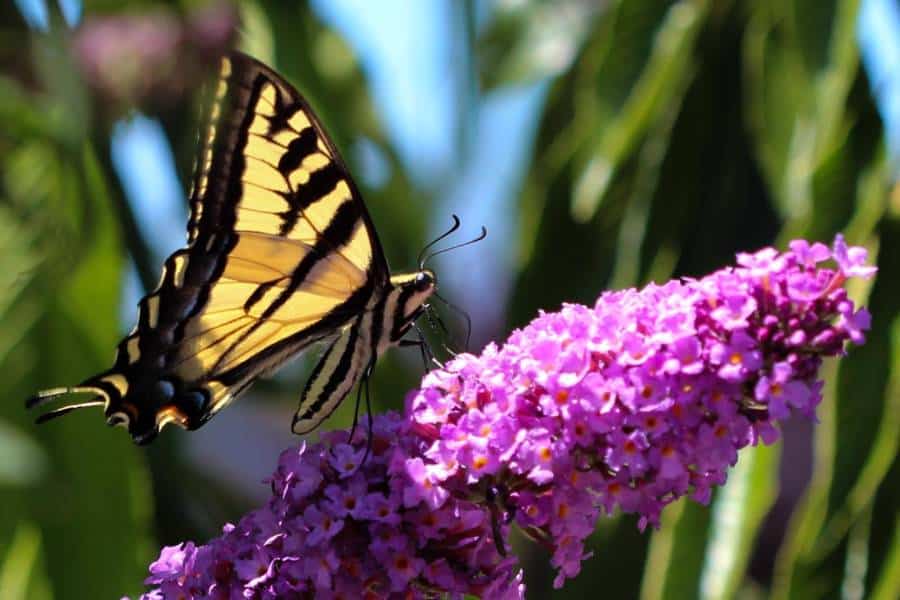
3. Agave
Live in a dry and drought-tolerant area? Check out the Agave plant.
Agave plants are low-water succulent. Their thick leaves store water and energy to last through dry spells. When you’re first establishing the plant, water it every four or five days. But once it’s settled, you can scale back to two to three times a month.
Despite the easy maintenance, Agaves provide some awe-inspiring beauty. The large and pointed leaves are dramatic and add some sophisticated landscaping to your deck or patio. There are several cultivars to choose from. Some feature two-tone colored leaves and splashes of color for even more beauty.
4. Blue Oat Grass
Blue Oat Grass is an ornamental grass species. It’s famously low-maintenance. As a result, it’s a favorite among landscapers and gardeners living in dry areas.
These plants only need a small amount of supplemental watering throughout the year. After the first year, most gardeners don’t even bother doing that. They’re hardy enough to last through dry seasons and will do fine with rain alone.
The only thing you should do to keep these plants looking good is to remove dead growth. Blue Oat Grass continually grows, resulting in brown and discolored reeds at the base. Cut those out to promote more growth and a manageable shape.
5. Sedum
If you’ve never heard of Sedum, you’re missing out. They are a type of succulent plant that’s slightly easy to care for. Many varieties exist, but most will grow with very little intervention from you.
Taller varieties may require the occasional prune and watering, but they hold up well if you neglect them a bit.
Sedum plants are sometimes called Stonecrops. They like to grow on walls or rocky surfaces. Low-growing varieties are often used to create living walls and dramatic landscape pieces.
These plants require good drainage and full sun. Beyond that, they are undemanding and very easy to care for.
6. Angelonia Serena
Here’s an easy plant that offers a big impact. Typically used for groundcover, Angelonia Serena grows well in shallow pots and baskets.
It’s an herbaceous perennial that comes in a wide variety of colors. Blossoms are small and stalk-like, creating a burst of color in the right container.
From a care standpoint, Angelonia Serena is fantastic. These plants are very drought tolerant. It’s best to water the plants whenever the soil is feeling dry to the touch. But if you fall behind a bit, the plant isn’t going to suffer too much.
The occasional fertilizer application every few weeks is always good. But, the Angelonia Serena can thrive without it if the soil is in good shape.
7. Geranium
Geraniums are a popular bedding plant that offers a low-maintenance way to get some color and fragrance in your garden. While you usually see them in beds, many gardeners choose to grow them in containers, too.
The cool thing about Geraniums is that they’re not very demanding in pots. They can grow in pots of any size or shape. As long as it has adequate drainage holes, you’re good to go.
Another big perk of the Geranium is its water preferences. The flowering plant loves to dry out between waterings. They are quite forgiving if you miss a watering here and there. Just hydrate the soil when you remember and the plant should perk right up.
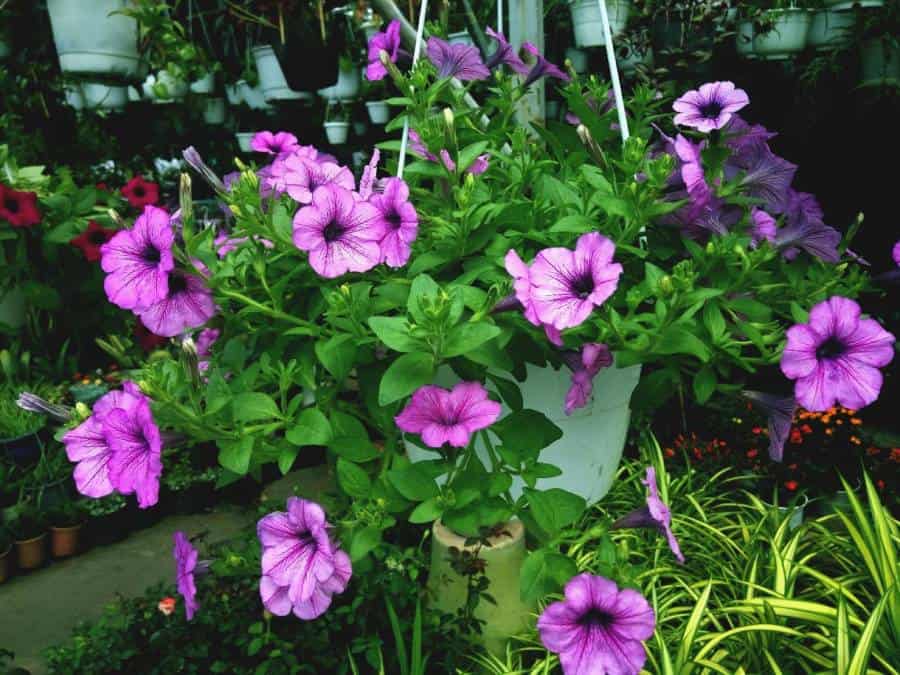
8. Rosemary
This culinary herb is a must for any home chef who wants to add a fresh touch to their meals. The leaves of the small plant contain tons of aromatic flavor. Rosemary is also compact and a cinch to care for.
The biggest draw of Rosemary is its resistance to pests. You can still encounter aphids here and there. But they are easy to get rid of with a simple splash of water.
The biggest problem Rosemary faces is powdery mildew. However, you can easily avoid that problem with adequate spacing and light watering. Keep the plant in a pot with good drainage and you should have no problems watching it flourish.
9. Heucheras
Sometimes called Coral Bells, Heucheras plants are some of the most eye-catching perennials around. They have large flat leaves that come in a spectrum of colors. You can find Heucheras cultivars in everything from black to bright yellow.
The Heucheras plant prefers to live in rich soil with good drainage. Regular watering during the first year is a must to keep the soil moist. But after that, you can scale back without any issues.
One positive aspect of this plant is its sun requirements. Heucheras grows regardless of sun exposure. It will thrive in full shade, full sun, and everything in between.
10. Cordyline
Cordylines are tropical plants that grow tall. They’re also very colorful, retaining hues of red, orange, and green all year long.
These plants do best in warm climates. They don’t take to cold very well, so prepare to bring them inside if you live in a cooler climate.
As for maintenance, Cordylines are pretty easy. In the early stages, you should keep an eye on the plant’s health. Keep the soil moist and provide fertilizer applications if it’s looking a bit worse for wear.
After the plant establishes itself in the pot, you shouldn’t have to worry about too many issues moving forward.
11. Aloe
Aloe plants are the quintessential “easy plant.” Revered for its medicinal properties, Aloe is a great plant to have outside. They grow slowly, but they look beautiful the entire time.
With its thick and pointy leaves, Aloe plants provide a striking look to any container garden. They grow in pots big and small, too.
In terms of care, Aloe is a cinch to keep healthy. They are succulents that hold water in the leaves. That’s why they’re so thick. Mature plants only need watering every three weeks or so. A slow, deep watering will keep them in good shape for a long time.
12. Lavender
Here’s a flowering plant that can turn your backyard into an aromatic oasis. Lavender does very well in containers. Many put them in decorative pots, which complements the burst of purple flowers that appear.
Lavender plants do require a bit more water when grown in containers compared to the ground. But, they are still quite drought-tolerant. You can miss a watering here and there without worrying too much about long-term damage.
These plants also resist frost well. Foliage may look dead and dormant. But in the right growing conditions, they can come back year after year with those signature purple blooms.
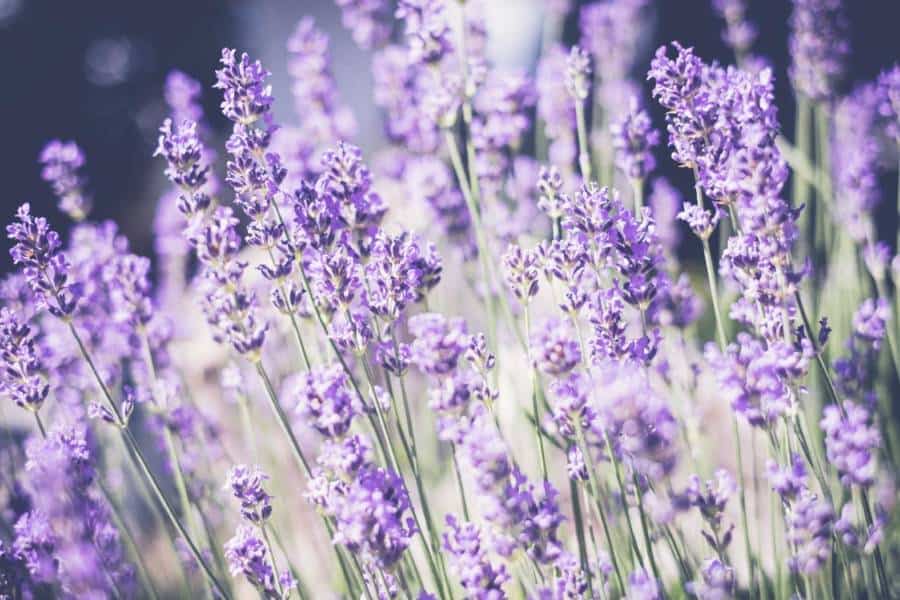
13. California Poppy
With its rich golden blooms, the California Poppy is a beautiful ornamental plant. You can get these plants as annuals or deep-rooted perennials. Either way, keeping them healthy is a cinch.
The flowering plant is very hardy and doesn’t mind growing in rougher conditions. In fact, California Poppies prefer disturbed soil. They like to have pebbles and rocks, as aggregate improves drainage.
The only maintenance task you should do is deadheading. Removing spent flowers will prevent seeds from forming. As a result, your plant can stay contained and avoid over-spreading. Deadheading will also promote future growth, which is always a plus.
14. Pansies
The garden Pansy is one of the most popular flowering plants out there. With its beautiful coloration, it’s not hard to see why. Available in many different cultivars, it’s not hard to find a variant that works in any climate.
Another advantage of growing Pansies is its minimal maintenance. Unlike other flowers, Pansies don’t require a ton of deadheading. They will continue to bloom regardless.
Pansies bloom throughout the spring. They’re a cool-weather flower, so excessive heat from the sun is not ideal. These plants do well in smaller 10-inch containers. You can also grow them in railing baskets and hanging planters.
15. Spotted Laurel
Spotted Laurels are a unique plant that you typically see as ground cover. Native to Asia, these plants thrive in shady moist environments. The same applies to container planting. Place the pot under a shady overhand. It will flourish nonetheless.
Despite its penchant for moist environments, the Spotted Laurel can tolerate a wide range of conditions. It resists damage from excessive heat and can hold up well to cold weather, too.
Not only that, but the Spotted Laurel resists most diseases.
These plants are an evergreen bush. The lush foliage features spots of pale yellow and gold. Occasionally, the plant will produce berries that attract birds.
16. Bluebell
Want a unique plant with vibrant flowers? The Bluebell might be up your alley. This flowering plant grows long blue flowers that droop down to form the shape of a bell. In full bloom, the weight of the flowers causes the stems to curve downward, creating a beautiful spread for the plant.
Bluebells don’t require a ton of watering, which is great for forgetful gardeners. In the first month, it’s good to water the plant every week while the roots take hold. However, the plant will only need about an inch of water a week thereafter. Bluebells enjoy moderately dry soil, so make sure to avoid overwatering.
17. Angelonia
Similar in appearance to Lavender, Angelonia plants are tall and vibrant. When they’re ready to bloom, thick stems will rise from the base. Then, flowers will start to pop up in all directions, creating colorful stalks of purple and pink.
Angelonia is one of the best container plants for bright and sunny spots. They do best in full sun, but partial shade works well, too.
With the right soil mixture, Angelonia is very low-maintenance. Soils rich in organic matter will reduce the need for frequent watering and fertilization.
These plants are also self-cleaning. So, that means they require very little deadheading if any at all.

18. Begonia
This gorgeous flowering plant is a classic. It’s sporting deep green and dark purple leaves. Blooms feature red petals and vibrant yellow stamen.
The cool thing about Begonias is that they are capable of blooming all year long in the right conditions. This typically occurs in warmer climates where temperatures rarely fall to levels that trigger foliage growth.
Begonias don’t require a ton of detailed care, either. Some light pruning in the spring is all you need. These plants like it when the soil dries a bit on the top layer. The best way to tell that the plant needs hydration is to stick your finger in the soil. If it’s dry to the first knuckle, give the plant a drink.
19. Petunia
Another iconic flowering plant, Petunias are a common sight in container gardens the world over.
Available in a myriad of colors, they are an easy way to bring some life and fragrance to your container garden. Petunias require very little care and will bloom for several months. As long as the plant is getting full or partial sun exposure, it will continuously flower throughout the spring, summer, and fall.
Furthermore, these plants only require watering about once a week. You may want to perform a bit of extra maintenance here and there. Light pruning in the middle of summer will help produce more blooms and prevent the plant from getting leggy.
20. Zinnia
Zinnias are large plants that work well in an outdoor container garden. Some cultivars can reach heights of four feet. Not only that, but they have thick foliage. They can help shade out weeds and keep your pot looking clean.
There’s no denying that the Zinnia plant is unique. A single plant can produce several different colors of flowers. Each one is round and bulbous, which makes for a nice bouquet.
Zinnias don’t need much in terms of fertilizer. Deep watering a couple of times a week is enough. The plants grow fast and will start developing flowers in as little as 60 days when cultivated from seed.
21. Jade
You might be familiar with Jade’s other name: The Lucky Plant. A popular indoor succulent, Jade plants can thrive when placed outdoors.
Jade plants can grow thick trunks and reach heights of five feet. However, some will stay relatively small, focusing their energy on producing those fleshy green leaves instead.
You can start Jade in a small pot that’s only a few inches in diameter. It will require transplantation when it gets bigger, but you can always plant it in a bigger pot to give it several years of growing time.
As a succulent, Jade doesn’t need watering every week. Wait until the top inch or two of soil dries out before watering.
22. Mother-in-Law’s Tongue
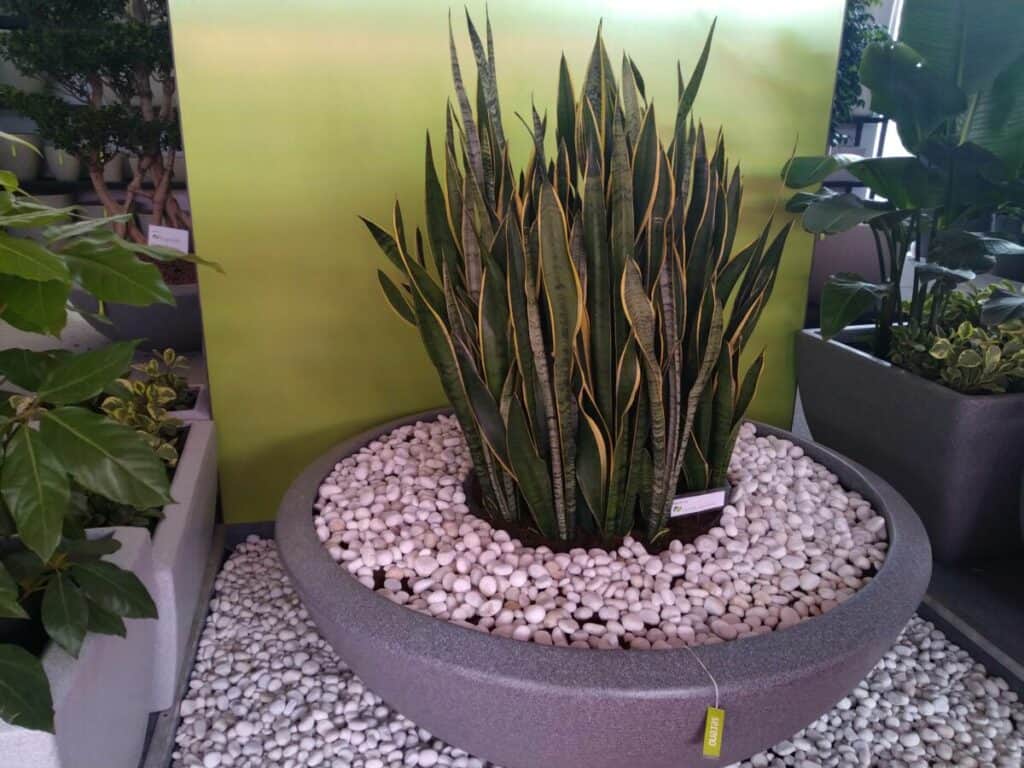
Here’s another popular houseplant that flourishes on decks, patios, and rooftop terraces. The Mother-in-Law’s Tongue plant, which is more commonly known as the Snake plant, produces tall leaves. The leaves are thin and feature stripes of yellow or white.
Blooming is rare, but you might encounter some flower-covered stalks when kept outdoors.
From a maintenance standpoint, Mother-in-Law’s Tongue is very easy. It doesn’t require a ton of water. It’s best to wait until the top layer of soil is dry to the touch.
Mother-in-Law’s Tongue plants are surprisingly resilient. They have a knack for spreading through underground rhizomes. Luckily, a good container will prevent the plant from being invasive.
23. Pothos
The Pothos plant is an undemanding shrub that you can put pretty much anywhere. Unlike most plants, this one doesn’t like direct sunlight. Excessive sun exposure could end up burning the delicate leaves. Pothos does best in indirect lighting or partial shade, making it an excellent choice for container gardens.
Prepare for tons of growth if you keep this plant outside. The Pothos is a vining plant. Individual vines can grow to lengths of 40 feet. If your plant gets that big, make sure to train it on a trellis or handrail for adequate support.
To keep the plant healthy, provide enough water to maintain moisture in the soil. Because these plants hate direct sun, waterings are going to be few and far between.

24. Cosmos
Cosmos are fast-growing annuals with large beautiful flowers. While short-lived, these plants make great seasonal projects for gardeners.
The low-maintenance characteristics start very early. These plants are easy to germinate. You can see success by simply scattering seeds on top of the soil in your pot. There’s no need to worry about keeping an eye on the germination process. They are self-sowing, which makes things super-easy.
Watering is important during the early stages of growth. But after it establishes itself, you don’t need to water it at all. The only exception is in times of drought. With standard rainfall, the plant gets everything it needs.
25. Hosta
Have a shady spot that needs some life? Place a Hosta plant there. Hostas are very shade tolerant and only need moderate sun exposure to thrive. Partial sun exposure in the mornings can help bring out the gorgeous color in the leaves.
Hostas don’t need much to grow. Once you have the right spot, you can forget about them. These plants need about an inch of water per week. But if you don’t live in an area that’s prone to drought, regular rainfall will take care of that task.
At the end of the season, just remove any dead leaves and branches, and the plant is good to go for next year.
26. Peonies
This soft and delicate flower is easier to grow than most think. True perennials, these plants can live for more than five decades. With every passing year, they get more beautiful and vibrant. Best of all, you can achieve this with very little care.
The trick is to plant the Peony in a pot that will last. These plants don’t take to transplants well, so you need to pick its forever container. A 10-gallon pot with adequate drainage will do just fine.
Taller cultivars may require a cage or trellis system to support the weighty flowers. But beyond that, these plants are easy to care for. They only need about an inch of water a week. For pruning, just cut the browning plant to the ground to prepare it for next year.
27. Daffodil
Daffodils are iconic perennials that can come back year after year. They do require a bit more care than some flowers. But, it’s easier than you think.
These plants grow from bulbs. It’s a good idea to remove the bulbs from the soil to store them away during the winter. However, you don’t have to worry about timing your dig like you would with other flowers. Daffodils will die down on their own. You should wait until the foliage is completely gone to remove them.
When your Daffodil is growing, they don’t need any special care. Just remember to water them consistently to avoid any major problems.
28. Coneflower
Coneflowers are one the hardiest flowering perennials. They are undemanding in just about every regard. These plants grow well in most soils. Not only that, but they can withstand harsh weather without missing a beat.
Another big advantage of having Coneflowers is that you don’t have to do anything come wintertime. The plant will go dormant on its own. It will look dead and withered. But when spring rolls around, these plants perk right up and produce those gorgeous flowers.
Choose a container that can hold two or three gallons. Make sure it’s deep enough to accommodate the plant’s taproot. Once you have the right pot, it’ll be smooth sailing.
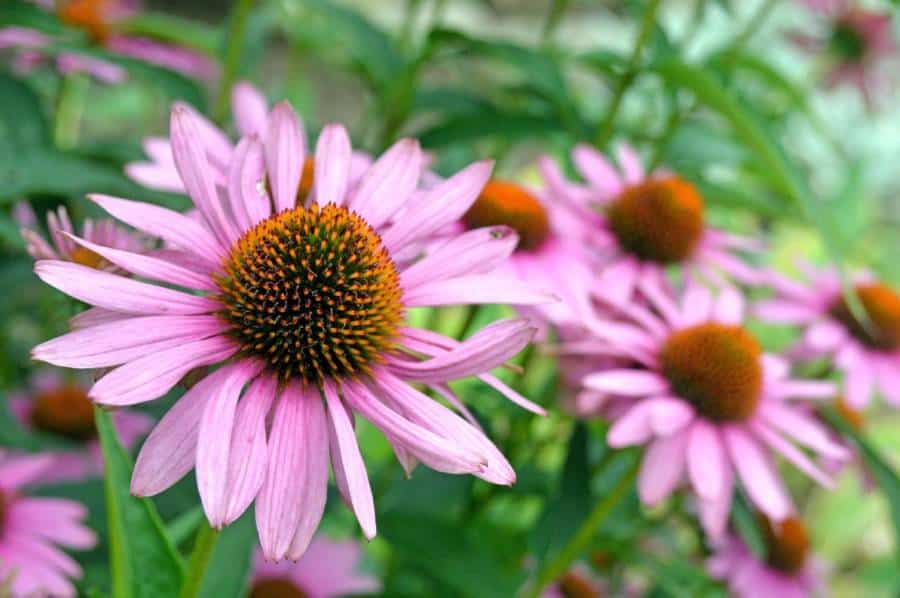
29. Hydrangea
This massive shrub doesn’t take much to grow. Yet, it creates a huge visual impact in a container garden. The plant produces large bunches of fragrant flowers in a slew of eye-catching colors.
Hydrangeas can get pretty big. Large varieties will grow to 15 feet tall and about 10 feet wide. Needless to say, a big container is a must. Go for a deep pot that’s at least 18 to 20 inches in diameter.
After planting, water your Hydrangea three times a week to promote root growth. Keep that watering schedule up until the plant is mature and ready to bloom. Then, scale back to only an inch of water a week.
30. Anemone
Simple and elegant, the Anemone plant makes a beautiful addition to any garden. The bulbs for this plant are quite small. As a result, they’re a favorite for container gardeners. You can plant several bulbs in a large container, as they only need an inch or two of space between them.
Well-draining soil that’s rich in nutrients is best. High-quality soil can reduce your need for fertilizer or frequent watering.
Anemone plants like moist soil. But, you should avoid overwatering at all costs. Only an inch per week is all they need. For sun exposure, keep these plants in partial shade. They perform better with indirect sunlight.
Fact Checked, Written, and Published by Kevin Rodrigues
Kevin is the founder of Gardening Mentor, a website that aims to teach people to grow their own food in a limited space. As a self-taught gardener, Kevin has spent several years growing plants and creating gardening content on the website. He is certified in Home Horticulture and Organic Gardening from Oregon State University. He has a Post Graduate Diploma in Horticulture and Landscape Gardening from Mumbai University.
Read more

